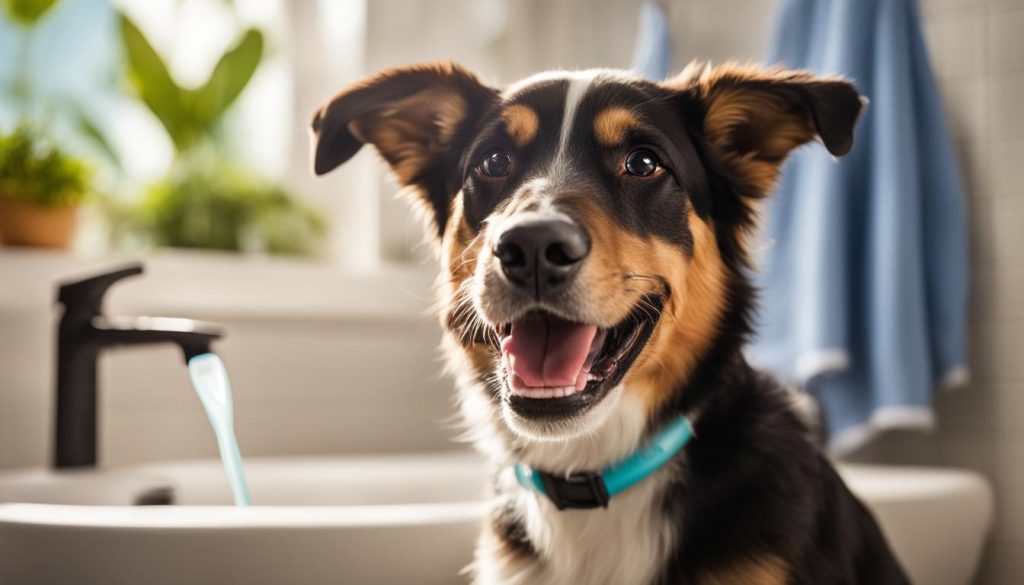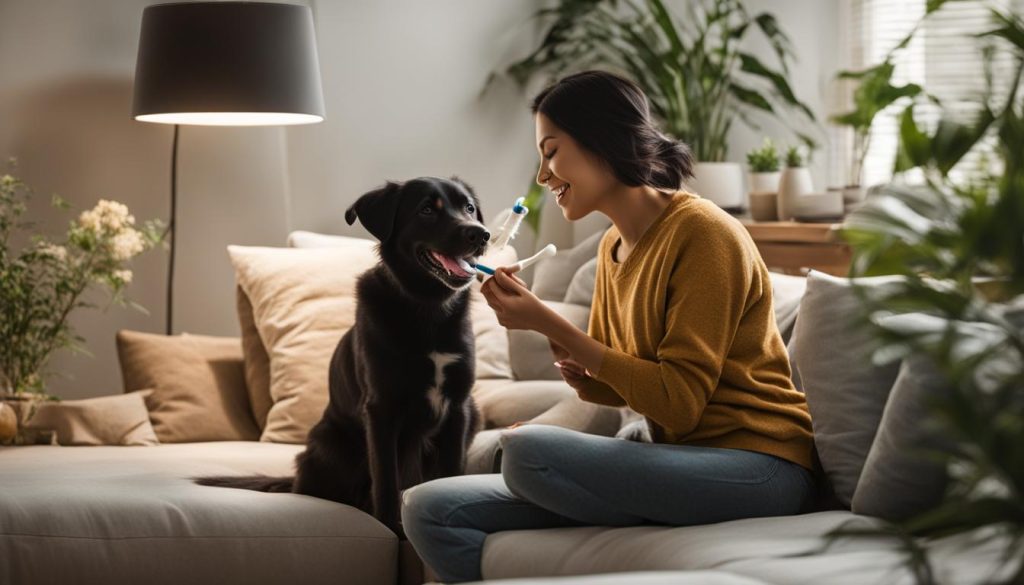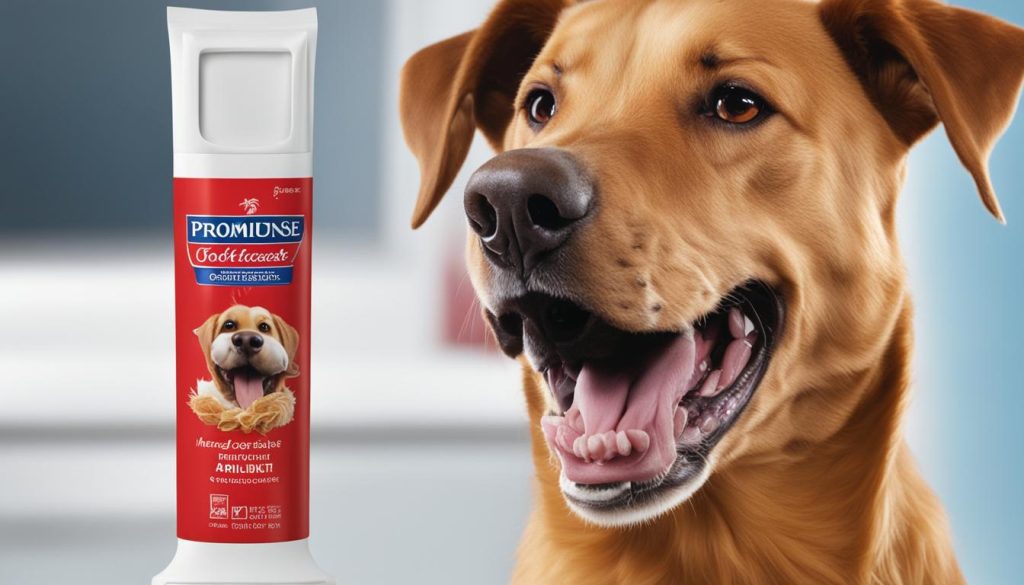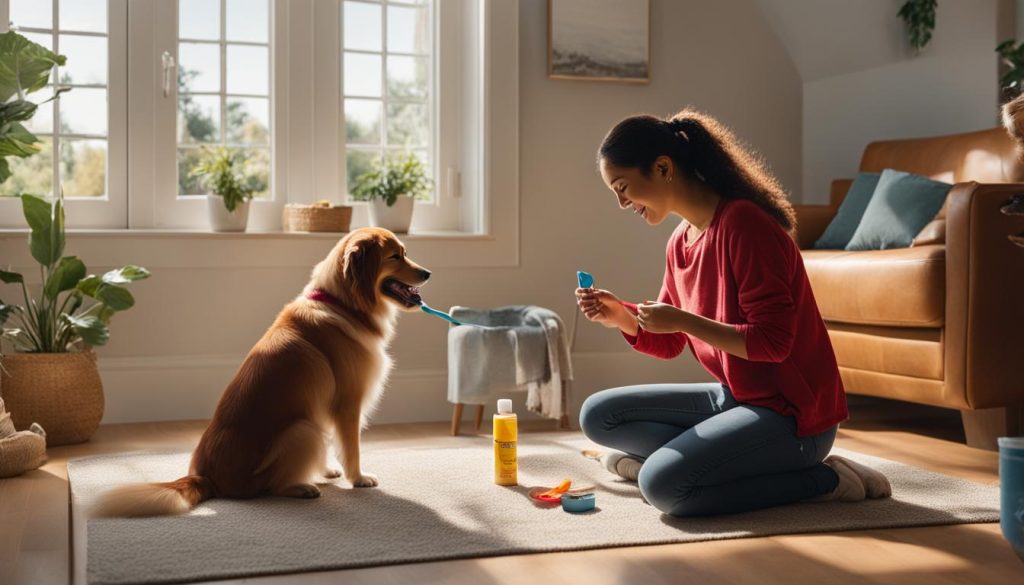Brushing your dog’s teeth is an essential part of their dental care routine. Regular brushing helps prevent plaque buildup, bad breath, gum disease, and tooth decay. Follow these steps to properly brush your dog’s teeth and ensure their oral hygiene.
Key Takeaways:
- Regularly brushing your dog’s teeth is crucial for maintaining their dental health.
- Use a toothbrush specifically designed for dogs and a dog toothpaste with a flavor they enjoy.
- Create a calm and comfortable environment for brushing your dog’s teeth.
- Introduce toothbrushing gradually, starting with mouth handling and toothpaste.
- Brush your dog’s teeth in small circles, focusing on areas with plaque buildup.
The Importance of Brushing Your Dog’s Teeth
Regularly brushing your dog’s teeth is crucial for maintaining their dental health. Without proper dental care, plaque can accumulate, leading to various oral health issues such as bad breath, gum disease, and tooth decay. Brushing your dog’s teeth helps remove plaque, prevent the formation of tartar, and reduce the risk of painful infections and life-threatening conditions.
According to the American Veterinary Dental Society, around 80% of dogs show signs of oral disease by the age of three. This statistic highlights the importance of proactive dental care for your furry friend. Just like humans, dogs require regular teeth brushing to maintain healthy gums and teeth. By incorporating dental care into your dog’s routine, you can improve their overall well-being and avoid costly dental procedures in the future.
Canine dental care goes beyond aesthetic reasons. In fact, dental issues can have a significant impact on your dog’s overall health. When bacteria from plaque and tartar enter the bloodstream, they can potentially affect other organs, including the heart, liver, and kidneys. Regular brushing helps remove the buildup of plaque and tartar, reducing the risk of these harmful bacteria causing systemic health problems.
By prioritizing dental care for your dog, you can ensure their dental health is maintained, preventing discomfort, pain, and potential health complications. Implementing a regular brushing routine and using appropriate dental products will contribute to your dog’s overall well-being and help them maintain a happy, healthy smile.

| Dental Care Benefits | Prevents | Reduces Risk of |
|---|---|---|
| Plaque buildup | Bad breath | Gum disease |
| Bacterial infections | Tooth decay | Systemic health issues |
| Tartar formation |
Tools for Brushing Your Dog’s Teeth
When it comes to brushing your dog’s teeth, having the right tools is essential. Using the correct equipment helps ensure a thorough clean without causing any harm or discomfort to your furry friend. Here are the two main tools you’ll need for brushing your dog’s teeth:
Dog Toothbrush
A dog toothbrush is specially designed with softer bristles and an angled head to make it easier for you to reach all areas of your dog’s mouth. The soft bristles are gentle on your dog’s gums, reducing the risk of irritation or injury. Choose a toothbrush size that is appropriate for your dog’s breed and size. If you have a small dog or a dog that is particularly sensitive to having their teeth brushed, consider using a finger brush. These slip onto your finger and have soft bristles on the tip, allowing for a gentle and controlled brushing experience.
Dog Toothpaste
Using toothpaste specifically formulated for dogs is vital. Dog toothpaste is formulated with flavors that are appealing to dogs, such as poultry or peanut butter, making the brushing experience more enjoyable for them. It is also important to note that human toothpaste should never be used on dogs. Human toothpaste often contains ingredients, such as xylitol, that can be toxic to dogs if ingested. Always opt for a toothpaste made specifically for dogs to ensure their safety and overall dental health.
By investing in a quality dog toothbrush and toothpaste, you’ll be well-equipped to provide your dog with the oral care they need to maintain good dental health. Remember to choose a toothbrush size appropriate for your dog’s breed and size, and opt for toothpaste flavors that your dog will find enticing. With the right tools in hand, you can make the teeth brushing experience a positive and beneficial one for both you and your furry companion.
Creating a Comfortable Environment
When it comes to brushing your dog’s teeth at home, creating a calm and comfortable environment is essential. Dogs are sensitive to their surroundings, and a positive atmosphere can make the experience less stressful for both of you. Find a quiet spot in your home where your dog feels at ease. This could be a corner of the room or a designated area where you typically engage in bonding activities.
It’s important to avoid standing directly above your dog or taking a threatening stance during teeth brushing. Instead, kneel or sit in front of or to the side of your dog. This posture helps reduce any perceived intimidation and makes your dog feel more comfortable. Additionally, be aware of your dog’s anxiety levels. If your dog seems upset or anxious, stop the brushing session and try again later when they are more relaxed.
Gradually introducing each step of the teeth brushing process can also help create a comfortable environment. Start by familiarizing your dog with the toothbrush, toothpaste, and the act of having their mouth handled. This gradual approach allows your dog to build trust and associate positive experiences with teeth brushing. Remember, patience is key, and consistency will go a long way in establishing a routine that your dog will become accustomed to.
| Creating a Comfortable Environment for Brushing Your Dog’s Teeth |
|---|
| • Find a quiet spot where your dog feels at ease |
| • Kneel or sit in front of or to the side of your dog |
| • Avoid standing above your dog or taking a threatening stance |
| • Gauge your dog’s anxiety levels and stop if they seem upset |
| • Gradually introduce each step to make brushing a positive experience |
Remember, the goal is to make teeth brushing a positive experience for your dog. By creating a comfortable environment, you can help alleviate any anxiety or fear associated with this activity, making it easier for both you and your furry friend.

Creating a Bonding Moment
Teeth brushing can also be an opportunity to strengthen the bond between you and your dog. It’s an intimate activity that requires trust and cooperation. By approaching teeth brushing with patience, kindness, and understanding, you can turn it into a bonding moment.
During the brushing session, talk to your dog in a soothing and reassuring tone. Offer words of encouragement and praise for their cooperation. Additionally, take breaks if needed, allowing your dog to relax and feel more comfortable throughout the process. After each successful brushing session, reward your dog with their favorite treat or extra attention, further reinforcing the positive association with teeth brushing.
“Teeth brushing is an opportunity to strengthen the bond between you and your dog.”
By focusing on creating a comfortable environment and turning teeth brushing into a bonding moment, you can make this important dental hygiene activity a positive and enjoyable experience for both you and your dog.
Getting Your Dog Used to Mouth Handling
Before introducing the toothbrush, it’s important to get your dog comfortable with having their mouth handled. This step is crucial in ensuring that the brushing process goes smoothly and that your dog remains calm and cooperative. To begin, gently rub your finger along your dog’s upper gums and teeth.
Use light pressure and repeat this step over multiple sessions until your dog becomes accustomed to the sensation of having their mouth touched. Be patient with your dog and gradually increase the duration of each session. This gradual approach helps build trust and familiarity, making the toothbrushing experience more positive for your dog.
By getting your dog used to mouth handling, you are laying the foundation for successful teeth brushing sessions. Remember to be gentle and patient throughout this process, and always reward your dog with praise and treats for their cooperation.

Table: Steps for Getting Your Dog Used to Mouth Handling
| Step | Description |
|---|---|
| 1 | Gently rub your finger along your dog’s upper gums and teeth. |
| 2 | Use light pressure and repeat this step over multiple sessions. |
| 3 | Gradually increase the duration of each session. |
| 4 | Be patient and reward your dog with praise and treats. |
Introducing Toothpaste
Once your dog is comfortable with mouth handling, it’s time to introduce toothpaste. This step is crucial in getting them accustomed to the taste and texture of the toothpaste, making the brushing experience more enjoyable for both of you. Remember to use a toothpaste specifically formulated for dogs, as human toothpaste can be harmful if ingested by your furry friend.
To start, place a small amount of dog toothpaste on your fingertip and allow your dog to lick it off. This will help them become familiar with the taste and texture of the toothpaste. If your dog refuses to lick more toothpaste after a few days, try a different flavor to find one that they enjoy. Please be aware that some dogs may take longer to adjust to the taste, so patience is key during this process.
While introducing toothpaste, it’s also a good idea to let your dog associate the toothpaste with positive experiences. For example, you can offer praise or a small reward after they lick the toothpaste. This positive reinforcement will further reinforce the idea that tooth brushing is a pleasant activity.

Table: Comparison of Dog Toothpaste Flavors
| Flavor | Description | Popular Brands |
|---|---|---|
| Chicken | A savory flavor that appeals to most dogs | Brand A, Brand B |
| Beef | A rich, meaty flavor that is enticing for dogs | Brand B, Brand C |
| Peanut Butter | A nutty flavor that dogs find irresistible | Brand C, Brand D |
Table: Comparison of Dog Toothpaste Flavors
As you can see from the table above, there are various flavors of dog toothpaste available on the market. Each flavor has its own unique characteristics that may appeal to different dogs. It’s worth experimenting with different flavors to find the one that your dog enjoys the most.
The Proper Way to Brush Your Dog’s Teeth
Brushing your dog’s teeth is an important part of their dental care routine. Follow these steps to ensure proper brushing and maintain your dog’s oral hygiene:
Step 1: Prepare the Tools
Gather the necessary tools for brushing your dog’s teeth, including a dog toothbrush and toothpaste formulated specifically for dogs. Avoid using human toothpaste, as it can be harmful if swallowed by your furry friend. Dog toothbrushes have soft bristles and angled heads to make brushing easier and more effective.
Step 2: Introduce Toothpaste
Let your dog get used to the toothpaste flavor by allowing them to lick a small amount off your finger. This helps familiarize them with the taste and texture of the toothpaste, making the brushing process more pleasant for both of you.
Step 3: Start Brushing
Gently lift your dog’s upper lip to expose their teeth and gums. Hold the toothbrush at a 45-degree angle against the gum line and brush in small circular motions. Focus on the outer surfaces of the teeth, as this is where plaque tends to accumulate the most. Gradually increase the number of teeth brushed each day until you can brush the entire mouth within two minutes.
Remember to be patient and gentle with your dog during the brushing process. If they become anxious or resistant, take breaks and gradually increase the duration of brushing sessions over time. Reward your dog with praise and treats after each successful brushing session to reinforce positive behavior.
| Step | Description |
|---|---|
| Step 1 | Gather the necessary tools: dog toothbrush and toothpaste formulated for dogs |
| Step 2 | Introduce toothpaste by allowing your dog to lick a small amount off your finger |
| Step 3 | Hold the toothbrush at a 45-degree angle against the gum line and brush in small circular motions |
Regular brushing of your dog’s teeth is essential for their dental health. By following these steps and establishing a consistent brushing routine, you can help prevent dental issues and keep your furry friend’s teeth clean and healthy.

Additional Dental Care Tips
Proper dental care for dogs goes beyond just brushing their teeth. Here are some additional tips to ensure your dog’s dental health:
- Provide dental chews and treats: Dental chews and treats can help remove plaque and tartar buildup, promoting healthier teeth and gums. Look for products that are specifically designed to improve dental health.
- Schedule regular professional dental cleanings: While brushing your dog’s teeth is important, professional cleanings are also necessary to remove stubborn tartar and assess the overall dental health of your dog. Consult with your veterinarian to determine the appropriate frequency for dental cleanings based on your dog’s specific needs.
- Monitor your dog’s diet: Proper nutrition plays a crucial role in your dog’s dental health. Feed them a balanced diet that includes dental-friendly foods. Avoid giving them too many sugary or sticky treats, as these can contribute to plaque buildup.
- Stay consistent: Maintaining good dental care for your dog requires consistency. Make brushing their teeth a regular part of their routine and stick to it. This will help prevent dental issues and ensure their long-term oral health.
By following these additional dental care tips, you can further enhance your dog’s dental health and ensure that their teeth and gums stay in optimal condition. Remember to always consult with your veterinarian for personalized advice and recommendations.
Table: Dental Chews Comparison
| Brand | Key Features | Price |
|---|---|---|
| Brand A | Contains natural ingredients, promotes fresh breath | $10 |
| Brand B | Helps reduce tartar buildup, suitable for small breeds | $8 |
| Brand C | Grain-free formula, supports healthy gums | $12 |
Table: This table provides a comparison of different dental chews available in the market. Each brand offers unique features and price points, allowing you to choose the best option for your dog’s dental needs.
Start Early: Dental Care for Puppies
When it comes to dental care for dogs, it’s best to start early. By introducing teeth brushing to your puppy at a young age, you can establish good oral hygiene habits that will benefit them throughout their life. Puppies’ teeth begin to erupt at around 3-4 weeks of age, and by 6-8 weeks, they should have a full set of baby teeth. This is the perfect time to start gently introducing them to the concept of tooth brushing.
To begin, use a soft toothbrush or finger brush specifically designed for puppies. You can also use a piece of gauze wrapped around your finger as an alternative. Start by simply touching your puppy’s lips and gently lifting them to expose their teeth and gums. This will help them get used to the sensation of having their mouth handled.
Gradually progress to using a small amount of puppy toothpaste on the brush or gauze. The toothpaste should be specially formulated for dogs and have a flavor that is appealing to your puppy. Slowly and gently brush their teeth in small circular motions, focusing on the outer surfaces. Be patient and make the experience positive by praising your puppy and offering them a treat afterward.
Table: Recommended Steps for Brushing a Puppy’s Teeth
| Step | Description |
|---|---|
| 1 | Introduce mouth handling |
| 2 | Gradually introduce toothpaste |
| 3 | Gently brush teeth in circular motions |
| 4 | Reward and praise your puppy |
Starting dental care early will help your puppy become comfortable with the brushing process and develop good dental hygiene habits. Remember to be patient and make each brushing session a positive experience. As your puppy grows, continue to brush their teeth regularly to maintain their oral health. If you have any concerns or questions about your puppy’s dental care, consult with your veterinarian for personalized advice.
Tailor Your Approach to Your Dog’s Needs
When it comes to brushing your dog’s teeth at home, it’s important to remember that each dog is unique and may have different needs and preferences. By tailoring your approach to suit your dog’s individual requirements, you can ensure a more positive and effective teeth brushing experience. Here are some tips to help you customize your dental hygiene routine:
- Observe Your Dog: Take note of your dog’s comfort level and anxiety levels during teeth brushing sessions. Pay attention to any signs of stress or discomfort, such as lip licking, yawning, or attempts to pull away.
- Gradual Progression: If your dog is new to teeth brushing or has had negative experiences in the past, start slowly and gradually increase the intensity and duration of brushing over time. This will help build their trust and make the process more manageable for them.
- Experiment with Tools and Techniques: Dogs have different preferences when it comes to toothbrushes and toothpaste flavors. Try different options to find what works best for your dog. You can also explore alternative brushing methods, such as finger brushes or dental wipes, if your dog is more comfortable with those.
By tailoring your approach to your dog’s needs, you can make teeth brushing a more enjoyable and beneficial experience for both of you. Remember, consistency and patience are key in establishing a successful dental hygiene routine.
Table: Customizing your approach to teeth brushing
| Step | Description |
|---|---|
| 1 | Observe your dog’s comfort level and anxiety levels during teeth brushing sessions. |
| 2 | Gradually increase the intensity and duration of brushing over time. |
| 3 | Experiment with different toothbrushes, toothpaste flavors, and brushing methods to find what works best for your dog. |
By following these guidelines, you can ensure that your dog receives the dental care they need in a way that suits their individual needs. Remember, brushing your dog’s teeth is an important part of their overall dental hygiene, and with a customized approach, you can make it a positive and rewarding experience for both you and your furry friend.
Wrapping Up
Ensuring your dog’s dental health is crucial for their overall well-being. By following the proper steps for brushing your dog’s teeth and using the right tools, you can help prevent dental issues and keep their smile healthy and happy.
Remember to establish a regular brushing routine and gradually introduce each step to make the experience positive for your dog. Take breaks if needed and reward them for their cooperation. Consistency is key in maintaining optimal dental health for your furry friend.
Additionally, don’t forget to provide additional dental care such as dental chews and treats to help fight plaque buildup. Schedule regular professional dental cleanings with your vet to ensure comprehensive dental care.
Consult with your vet for personalized advice and recommendations based on your dog’s specific needs. By staying proactive and committed to your dog’s dental care, you can help them have a healthy and beautiful smile for years to come.
FAQ
Why is brushing my dog’s teeth important?
Brushing your dog’s teeth is important because it helps prevent plaque buildup, bad breath, gum disease, and tooth decay. Regular brushing is essential for maintaining their dental health.
What tools do I need to brush my dog’s teeth?
To brush your dog’s teeth, you’ll need a toothbrush specifically designed for dogs with soft bristles and an angled head. Finger brushes are suitable for smaller dogs. Use dog toothpaste that has a flavor your dog enjoys, like poultry or peanut butter.
How do I create a comfortable environment for brushing my dog’s teeth?
Find a quiet spot where your dog feels at ease. Avoid standing above them or taking a threatening stance. Kneel or sit in front of or to the side of them. Gradually introduce each step to make brushing a positive experience for your dog.
How do I get my dog used to mouth handling?
Gently rub your finger along your dog’s upper gums and teeth to acclimate them to the sensation. Use light pressure and repeat this step over multiple sessions until your dog is used to having their mouth touched.
How do I introduce toothpaste to my dog?
Place a small amount of dog toothpaste on your fingertip and let your dog lick it off. This helps them become familiar with the taste and texture of the toothpaste. If your dog refuses to lick more toothpaste after a few days, try a different flavor.
How do I brush my dog’s teeth?
Lift your dog’s upper lip and use a toothbrush with toothpaste. Angle the bristles at a 45-degree angle against the gum line and brush in small circles. Start with a few teeth at a time, gradually working up to more each day. Aim for a total brushing time of two minutes.
What do I do if my dog becomes anxious or resistant during brushing?
Take breaks if your dog becomes anxious or resistant. Gauge their comfort level and resume brushing at a later time. Maintain a light and positive mood, talking to your dog and offering praise. Stop when everyone is still having fun.
Are there any additional dental care tips for my dog?
Consider providing dental chews and treats that help fight plaque buildup. Schedule regular professional dental cleanings with your vet. Consult with your vet to determine the appropriate frequency for dental cleanings based on your dog’s specific needs.
When should I start brushing my dog’s teeth?
It’s best to start brushing your dog’s teeth when they are still puppies. This helps them become accustomed to the process and establishes good dental hygiene habits early on. If you have an older dog, it may take more time and patience to introduce teeth brushing, but it is still beneficial for their oral health.
Do I need to tailor my approach to my dog’s needs?
Yes, every dog is different, and some may require a more personalized approach to teeth brushing. Observe and adapt to your dog’s comfort level and anxiety levels. Your dog’s dental health is a lifelong commitment, and it’s important to tailor your approach to meet their specific needs.






